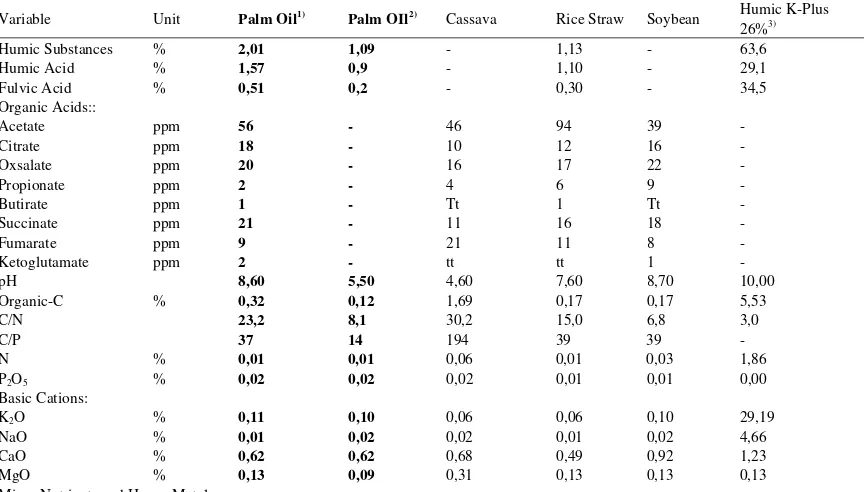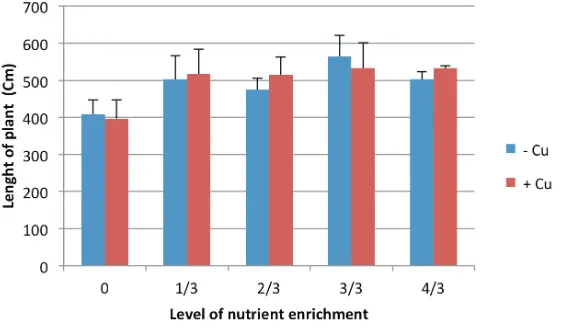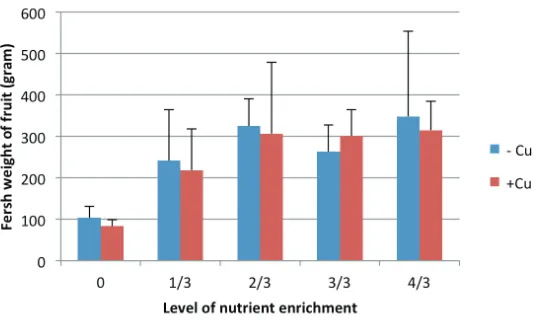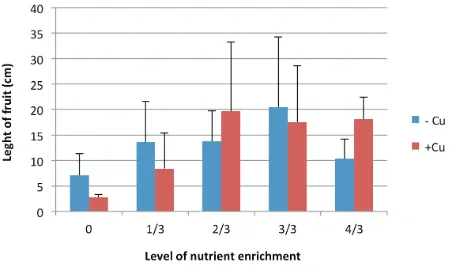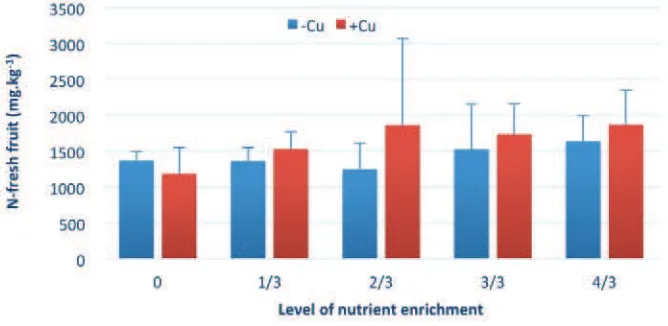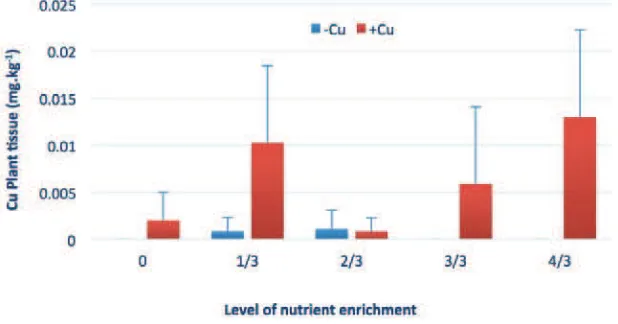Agriculture and Agricultural Science Procedia 9 ( 2016 ) 146 – 157
2210-7843 © 2016 The Authors. Published by Elsevier B.V. This is an open access article under the CC BY-NC-ND license (http://creativecommons.org/licenses/by-nc-nd/4.0/).
Peer-review under responsibility of the organizing committee of IC-FANRes 2015
doi: 10.1016/j.aaspro.2016.02.110
ScienceDirect
ScienceDirect
ScienceDirect
International Conference on Food, Agriculture and Natural Resources, IC-FANRes 2015
Effectivity of Humic Substance Extracted from Palm Oil Compost as Liquid
Fertilizer and Heavy Metal Bioremediation
Sugeng Winarso*, Martinus H. Pandutama, and Lutfi Dwi Purwanto
Soil Departement, Agricultural Faculty, University of Jember Jln. Kalimantan 37 Kampus Tegal Boto Jember, 68121. Indonesia
Abstract
Humic substances extracted from compost materials were proven able to chelate heavy metals. While the waste from Palm oil as the source material of compost is increasing, consequently the humic substances production from palm oil waste is promising. On the other hand, agricultural lands that were treated with high input which caused heavy metal accumulation (pollutant) up to hazardous level also increasing. The aim of this research was to evaluate the effectiveness of humic substance extracted from Palm Oil compost as liquid fertilizer and bioremediation of copper (Cu). The experiment was designed to discover a product which effectively improved the characteristics of acid soils, bioremediation of heavy metals, and plants production. The results of the experiment revealed that the content of pure humic substance extracted from compost of Palm Oil empty bunches waste was very low, 2.01%. It also contained very low in N, P, and K, which were 0.01%, 0.02%, and 0,11% of N, P2O5, and K2O
respectively. The treatment of metal Cu as much as 300 mg Cu(OH)2.kg -1
into the media added with humic substance enriched with NPK (4.38; 8.24; and 9.24) showed non significant differences on some cucumber plant variables. NPK enrichments to humic substance showed significant differences on some agronomic variables than that of control. The length of plant treated with 3/3 NPK enrichment revealed the longest average of 564.2 cm, or increased by 38%. The highest fresh weight was obtained by 4/3 treatment followed by 2/3 rate of NPK enrichment. Whie the longest cucumber fruit was obtained by 3/3 rate. Total soil N was very low, consequently the NPK sorption by cucumber was very low. While soil P availability was high, however the NPK enrichment lowered the fresh cucumber fruit P content instead. The ratio of NPK nutrients in plant and in soil was higher if treated with Cu addition compared to that of control.
© 2015 The Authors. Published by Elsevier B.V.
Peer-review under responsibility of the organizing committee of IC-FANRes 2015.
Keywords: biofertilizer, bioremediation, humic substance, copper, cucumber
Corresponding author. Tel.: 62-331-334054
E-mail address: winarsosugeng@unej.ac.id
© 2016 The Authors. Published by Elsevier B.V. This is an open access article under the CC BY-NC-ND license (http://creativecommons.org/licenses/by-nc-nd/4.0/).
1.Introduction
The previous research results indicated that humic substabces extracted from some compost materials were effectively and more rapidly improved soil chemical properties of marginal or acid soils. It could decrease exchangeable Al and increased soil P availability through chelating process (Winarso, et al, 2009a; 2010), therefore it could be an alternative to cope with problems of marginally acid soils in Indonesia, which covered almost 102.8 million ha (Puslitbangtanak, 2006). On the other hand, intensive agricultural lands were under harmful condition, due to high content of high heavy metals. Wang (2006), stated that more than 10% of cultivated lands were contaminated with Cd, As, Cr, and Pb, which caused production lost more than 10 million tons, and more than 12 million tons agriculture product per year became hazardous, which also caused economical lost at least 3 billion US dollars per year.
Heavy metals accumulation varied along with plant species, and generally higher on dicotyedoneael compared to monocotyledoneae plants (Taub and Goldberg, 1996). While, on the other hand, the potential agricultural/organical waste, especially from palm oil was very abundant, approximately 6 million tons empty bunches in 2004 ( 23% of total), excluding of wet decanter solid (4%), stem (6.5%), fiber (13.0%), and liquid waste (50%). Based on the data released by Ditjenbun (2006), within the last 20 years, the addition of Palm Oil Estate areas reached 5 million hectares, or increased by 837%.
Up to nowadays, the utilization of organic waste for soil was just as composting, without any added values, therefore its commercial value was low. Increasing commercial value of compost by extracting it to produce humic substabces was a very promising practice.
The humic substances extracted from compost could utilized as the raw material of biofertilizer and environmentally friendly bioremediation for heavy metals. In addition, humic substances have superior characteristics compared to that derived from mining (Leonardit) which
has been marketed commercially, especially abroad (Winarso, et al., 2009b).
Humic substances originated from mining contained very high Na, approximately 5%., while Na is generally needed by plants in very small amount. In fact, if Na is continuously added to soil, would cause soil compacted and dispersed when wet, and became easily eroded.
The mass and cheap production of humic substances usually would harvest low concentration, and its characteristic was determined by the quality of its raw materials. Therefore, some efforts should be applied to activate its functional groups, such as through pH manipulation and adding synthetic organic substances rich in functional groups. In addition, enriching humic substances with nutrients is very useful and beneficial to improve its functions and purposes as soil conditioner, fertilizers, and as heavy metals bioremediation. The chelating capability of humic substances could improve their main function as bioremediation for heavy metal or other soil-environment pollutants
The aim of this research was to evaluate the effectiveness and the capability of humic substance extracted from Palm Oil bunches waste in improving cucumber (or other plants) production and in reducing soil Cu (heavy metals) content.
2.Materials and methods
This research was performed at the Faculty of Agriculture, the University of Jember, during year 2013 to 2014. The main material utilized in this research was humic substance extracted from paln oil waste, which then enriched by macro nutrients, N, P, and K. The amount of N, P, and K applied were based on the fertilizer recommendation for Cucumber and the treatments
applied. The N, P, and K amount were: 4,38:8, 24:9,24 or 4,38% N; 8,24% P2O5; and 9,24%
The humic substance was harvested from the solution originated from composting process of Palm Oil empty bunches. The composting process was undergoing naturally without any additional enhancing materials, but only water and plastic cover to maintain the moisture content.
Palm oil waste ustilized in the research was collected directly from the production process. The humic substances accumulated from the process contained: 4000 ppm C or approximately 2000 ppm humic substance (Stevenson, 1982). The other humic substance characteristics were presented in Table 1.
Table 1., showed that humic substance derived from Palm Oil waste contained N, P, and K low to very low, therefore it needed to be enriched to improved their functions to be used as liquid fertilizer.
The enrichment of humic substance as to be in line with the research treatments was
conducted by adding 4000 ppm C; 2.71 kg Urea 46% N; 6.54 kg SP 36% P2O5; and 4.8 kg KCl
60% K2O. The planting medium utilized was 8 kg of soil in each polybag. The plant indicator
used was the Cucumber, which then planted at the field. Some plant and soil variables were then measured within and during 6 weeks.
The experimental design used for this research was Randomized Complete Block Design (RCBD) having two factors. The first factor was the rates of NPK enrichment materials per plant. Those were as follows: Control (No NPK enrichment), 1/3 of recommended rate (1/3 NPK: 3.3 gr Urea, 7.7 gr SP-36, and 5.7 gr KCl per plant); 2/3 of recommended rate (2/3 NPK: 6.7 gr Urea, 15.3 gr SP-36, and 11.3 gr KCl per plant); 3/3 of recommended rate (3/3 NPK: 10 gr Urea, 23 gr SP-36, and 17 gr KCl per plant); and 4/3 of recommended rate (4/3 NPK: 13.3 gr Urea, 30.7 gr SP-36, and 22.7 gr KCl per plant).
The second factor was the rates of Cu heavy metal (Cu(OH)2), as follows: 0 (Control): 0 mg
Cu(OH)2.kg-1 soil medium; and 1: 300 mg Cu(OH)2.kg-1 soil. The treatment combination of this
experiment were replicated 3 times.
Table 1. Chemical Characteristics of humic substance extracted form Palm Oil Bunches Compost and Other Humic Substabces
Variable Unit Palm Oil1)
Palm OIl2)
Variable Unit Palm Oil1)
Palm OIl2)
Cassava Rice Straw Soybean Humic K-Plus 26%3)
Source of waste process; 3)
Traded Products of Australian Industries (Winarso et al., 2009).
3.Results and discussion
3.1.Characteristics specific of humic substance extracted from palm oil compost
In general, the levels of N, P, and K macro nutrients of composted waste oil palm bunches were low and very high in C/N ratio. Palm oil waste in the form of empty bunches would take quite longer time to decompose compare to other plant waste such as soybean and rice plants waste. This is due to its very high C/N ratio, which is approximately 50 to 60. The results of Yunindanova (2009) research also revealed that crushed empty bunches Palm oil waste with C/N ratio about 41.8 took 10 weeks to decompose. Complete data empty bunches Palm oil waste decompositions were listed in Table 2. Decomposition process in this research was allowed undergone naturally to avoid additional nutrients from outside.
Table 2. Concentration of nutrients in palm oil bunches compost
Time
The NaO content of K-Humic plus 26% was 4.66%, while its content of Palm oil waste compost was 0.01%, and was 0.02% from Palm oil industrial waste. In stabilizing the high Na
content usually was enriched by stabilizing cations such as K and Ca (K2O and CaO). The K2O
content in commercial humic substance, K-Humic Plus 26% was 29.19%.
The organic acids content in humic substance extracted from Palm oil waste compost
consisted of acetic acid (CH3COOH, both aliphatic and single carbocilic), which was 56% of the
total 56% of a total of 8 organic acids analized. All of that acids (Acetic, Fumaric, Cetogltamic, Succinic, Propionic, Butiric, Oxalic, and Citric acids) contained carbocilic functional groups
(-COOH), both double and single bond (Hart et al., 2003). These functional group will dicosiate
their protons (H+), and produce negative charge acids or substances, which then will chelate Al
or other metals in soil (Essington and Anderson, 2008).
The chemical characteristics of humic substance extracted form Palm oil bunches compost and other humic substabces showed in Table 1. indicated that humic substances extracted from compst of different sources (palm oil and rice straw) relatively have the same charecteristics except their quantity. Those data could improve the previous information which stated that the characteristics of humic substances significantly depending upon their source materilas. The differences of their variables were on their value. The humic substance of Palm oil empty bunches had pH 8.6 which higher than humic substances of rice straw with pH 7.6.
3.2.Agronomic variables of cucumber on treatment of Cu addition and rates nutrient (NPK) enrichment
Cucumber agronomic variables used to evaluate the treatment effect Cu addition and the addition of various concentrations of nutrients (NPK) enrichment on humic substances are: length of plant, number of leaves, fresh weight of fruit and length of fruit showed in Figure 1 to 4.
Figure 1. The cucumber length of plant on treatments of Cu addition and level of nutrient enrichment
Based on field measurements indicated that the length of the cucumber plants on the treatment of Cu addition and rate of nutrient enrichment are showed in Figure 1. The addition of Cu (300
mg Cu(OH)2.kg-1 soil) in several of humic compounds enriched nutrient doses were not
Length of plant of the treatment 3/3 rate of nutrients (NPK) enrichment showed the greatest elongation of plants averaging 564.2 cm or up 38.5%.
Figure 2. Number of cucumber leaves on treatments of Cu addition and level of nutrient enrichment
Increasing the length of the cucumber was followed by the number of leaves (Figure 2). The number of leaves in the rate 3/3 of nutrients (NPK) enrichment showed the greatest with an average of 82 cm or up 59% than control (no NPK enrichment). Level of nutrient enrichment 3/3 was the best effect on length plants and leaves number was not followed by the production of fresh weight of fruit cucumber. The highest fruit fresh weight on 4/3 level NPK enrichment and followed by 2/3. Completed result of the fresh weight of the fruit is showed in Figure 3. But after seen length the fruit (Figure 4), the highest in the treatment of 3/3, as well as on the length and number of leaves.
Figure 4. The length of fruit cucumber on treatments of Cu addition and level of nutrient enrichment
Evaluation of the use of water cucumber plants for 50 days of growth in 8 kg soil is showed in Figure 5. Based on Figure shows that the water needs to follow the pattern of cubic by the formula Y = -1,093x2 + 77,10x + 1034 (Y = crop water requirement in ml and x is the age of the plant in days). This water needs, especially just for transpiransi, because evaporation does not occur or can be ignored because pot cultivation covered with plastic.
Figure 5. The use of water during cucumber growing on treatments of Cu addition and level of nutrient enrichment
3.3.Level nutrients NPK in soil and cucumber tissue and Cu in cucumber tissue
The treatment of nutrient enrichment in humic compounds extracted from palm oil compost combined with the addition of Cu does not significantly raise the level of N-total soil after
harvest (Figure 6). Levels of N-total soil is approximately 150 mg N.kg-1 or relatively very low.
Hardjowigeno (1995) said hight levels of total soil is varies between 5,100 to 7,500 mg N.kg-1.
The condition or status of N soil is very low impact on content of N-tissue in the cucumber fruit low (Figure 7). Relationship or correlation N-total soil with N concentration in fruit tissue is low, r = 0.21 and the average ratio between N in tissue with soil around 10.2 N. It is mean content N in the tissue higher than in the soil. These ratio comparison showed the treatment of Cu addition
is higher than is not treated with Cu. Figure 7 also showed that the addition of Cu in Cu(OH)2
300 mg.kg-1 tend to increase the levels of N in tissue cucumber. Increased N in the fruit
Figure 6. N-soil level at time of harvest on treatments of Cu addition and level of nutrient enrichment
Figure 7. The N concentration of fresh cucumber fruit on treatmens of Cu addition and level of nutrient enrichment
By contrast with the level of N-total soil, the availability or content of P-available soil after
harvest is very high and varies between 50 and 60 mg P2O5.kg-1. Generally, said level of
P-available is high varies between 26 to 35 mg P2O5.kg-1. These high P-available in soil effected
not significantly on the addition of humic substances enriched NPK. In addition, Figure 8 showed the addition of humic compounds enriched macro nutrients had lower levels of P in
cucumber than not added. The amount of diminution was average 0.32 mg P2O5.kg-1. It appears
Figure 8. P-soil level at time of harvest on treatments of Cu addition and level of nutrient enrichment
Figure 9. The P concentration of fresh cucumber fruit on treatments of Cu addition and level of nutrient enrichment
Figure 11. The K concentration of fresh cucumber fruit on treatments of Cu addition and level of nutrient enrichment
K-available soil after harvest high to very high, varying between 0.51 to 1.04 and an average
of 0.76 mg K2O.kg-1 soil. Correlation K-available soil with K-tissue fruit was 0.29 or low. The
ratio K tissue fruit : K soil around 27.93 with it’s ratio the treatment of Cu addition is higher than is not treated with Cu
Figure 12. The Cu concentration of fresh cucumber fruit on treatments of Cu addition and level of nutrient enrichment
Addition of heavy metal Cu in the form Cu(OH)2 in the growing media of cucumber shown to
increase the levels of Cu in fruit cucumber. Figure 12 showed treatment of Cu significantly increase the uptake of Cu or the Cu content in the fruit cucumbers, particularly indicated in the treatment rates of nutrient enrichment 1/3, 3/3, and 4/3 to control. Concentrations of Cu in these tissue are still much smaller when compared with the results Moreira et al. (2011) in soils
polluted weight Zn. The results showed Zn in tissue Verbascum virgatum, Hypochoeris radicata,
Phalaris arundinacea, Conyza bilbaoana, Paspalum urvillei and Aster squamatus varies from 34
mg.kg-1 in the stems and leaves of up to 2,440 mg.kg-1 in the roots. Therefore, this condition
when associated with the production of fruit showed that the addition of Cu at 300 mg.kg-1 did
grocery greens, cabbage, and Japan herbs) on the uptake of heavy metal contaminants (Cd, Pb, Cr, Cu and Fe) indicate the tomatoes absorb most compared with other crops, khususya the metals Cd. Metal accumulation in these tomatoes will increase if the plants are planted in a mixture with other plant species.
4.Conclusions
Based on the discussion can be concluded as 1) Addition of Cu (300 mg Cu(OH)2.kg
-1
soil) and humic compounds enriched rates of nutrients (NPK 4.38: 8.24: 9.24) were not significantly effect to the fruit cucumber production, 2) Humic compounds enriched 3/3 rates NPK showed the greatest treatment in contributing elongation of plants averaging 564.2 cm or up 38.5%, 3) Fresh weight of fruit cucumber is not effected the treatment humic compounds enriched rates of nutrients (NPK) and added Cu, 4) Levels of N-total soil is so low that NPK uptake cucumber is very low, whereas the levels of P-available soil is so high that treatment humic compounds enriched NPK had lower levels of P in the tissue of cucumber fruit, 5) The ratio NPK in tissue: in soil is larger in treated with the addition of Cu than not added.
Acknowledgements
We wish to thank Muhammad Ilham on his help in conducting this research. This paper is part of applied research result founded by Directorate of Research and Community Service. Indonesian Ministry of Education and Culture 2013.
References
Adam, F., Moore, B.L., 1983. Chemical factors affecting root growth in subsoil horizons of Coastal Plain Soils. Soil Sci. Soc. Am. J. 47, 99-102. Alloway, B.J., 1990. Soil processes and behavior of metal. In: Heavy Metals in Soils. 2nd
. Blackie Glasgow and London Halstead Press. John Wiley and Sons Inc. New York.
An, L., Pan, Y., Wang, Z., Zhu, C., 2011. Heavy metal absorption status of five plant species in monoculture and intercropping. Plant Soil 345, 237–245.
Balai Penelitian Tanah., 2006. Potensi Lahan Kering Masam untuk Pengembangan Pertanian. Warta Penelitian dan Pengembangan Pertanian 28(2), 16-17.
Bianchi-Hall, C.M., Carter, T.E., Bailey, M.A., Mian, M.A.R., Rufty, T.W., Ashley, D.A., Boerma, H.R. Arellano, C., Hussey, R.S., Parrott, W. A., 2000. Aluminum Tolerance Associated with Quantitative Trait Loci Derivedfrom Soybean PI 416937 in Hydroponics. Crop Sci. 40, 538–545.
BPS., 2010. http://www.bps.go.id/tnmn_pgn.php?eng=0.Dikases 17 Maret 2012.
Cerdan, M., Alcaniz, S., Juarez, M., Jorda, J.D., Bermudez, D., 2007. Kinetic Behavior of Fe(o,o-EDDHA)–HumicSubstance Mixtures in Several Soil Components andin Calcareous Soils. J. Agric. Food Chem. 55, 9159–9169.
Dolling, P.J., Porter, W.M., Robson, A.D., 1991. Effect of soil acidity on barley production in the south-west of Western Australia1.The interaction between lime and nutrient application. Australian Journal of Experimental Agriculture 31, 803-810
Faurie, G., Fardeau, J.C., 1990. Can acidification associated with nitrification increase e available soil phosphate or reduce the rate of phosphate fixation?Biol Fertil Soils.10, 145-151
Flis, S.E., Glenn, A.R., Dilworth, M.J.. 1993. The Interaction Between Aluminum and Root Nodule Bacteria. Soil Biol. Biochem. 25(4), 403-417. Kifuko, M.M., Othieno, C.O., Okalebo, J.R., Kimenye, L.N., Ndung’u, K.W., Kipkoech, A.K., 2007. Effect of combining organics residues with Ninjingu phosphate rock on sorption and availability of phosphorus and maize production in acid soils of Western Kenya. Expl Agric. 43, 51–66.
Leenheer, J.A., Wershaw, R.L., Reddy, M.M. 1995. Strong-acid, carboxyl-group structures in fulvic acid from the Suwannee River, Georgia. 2. Major structures. Environ. Sci. Technol. 29, 399–405.
Lindsay, W.L., 1979. Chemical Equilibria in Soils. A Wiley-Interscience Publication. Toronto.
McLaughlin, M.J., Alston, A.M., and Martin, J. K. 1988. Phosphorus cycling in wheat-pasturerotations. 1. The source of phosphorus taken up by wheat. Aust. J. Soil Res. 26, 323–331.
Sanchez, P.A., Logan, T.J., 1992. Myths and science about the chemistry and fertility of soil in the tropics. In: Lal, R. And P.A. Sanchez (eds.). Myths and science about the chemistry and fertility of soil in the tropics. SSSA Special Publ. No. 29. Soil Science Society of America, Inc. Madison, Wisconsin. USA.
Soepardi, G., 1983. Sifat dan Ciri Tanah. Institut Pertanian Bogor. Bogor.
Stevenson, F.J., 1982. Humus Chemistry, Genesis, Composition, Reaction. A Wiley-Interscience Pub.John Willey and Sons. Toronto.
Sugiharto, E., Martono, E., Wahyuningsih, T.D., Suratminingsih, L., 2009. Laporan hasil kegiatan Status dan pola sebaran logam berat pada lingkungan pertanian di Propinsi DIY. LPPM UGM dengan Badan Penelitian dan Pegembangan Pertanian.
Tipping, E., 2004.Cation Binding by Humic Substances. Cambridge University Press. Cambridge. Vlamis, J., 1953. Acid soil in fertility as related to soil solution and solid phase effect. Soil Sci 75, 383-393.
Waluyo, S.H., 2000.Biological Nitrogen Fixation of Soybean in Acid Soils of Sumatra, Indonesia..The Netherlands. Wageningen.
Winarso, S., 1996. Pengaruh penambahan bahan organik segar dan dikomposkan terhadap pengkelatan alumunium oleh senyawa-senyawa humik pada Typic haplohumult. Tesis S2. Institut Pertanian Bogor.
Winarso, S., Handayanto, E., Taufiq, A., 2010. Aluminum detoxification by Humic Substance extracted from Compost of Organic Wastes. Jurnal Tanah Tropika. 15(1), 19-24.
Winarso, S., Setiawati, T.C., Mudjiharjati, A., 2006. Viabilitas Beberapa Bakteri Pelarut Fosfat dalam Media Senyawa Humik Yang Diberi Zeolit. Agrin 10(1), 34-43.
Winarso, S., Handayanto, E., Shekhfani, Sulistyanto, D., 2007. Pemaduan Pseudomonas putida 27.4B dan Trichorderma sp. dalam Media Cair Senyawa Humik yang Diberi Zeolit untuk Mendapatkan Produk Multifungsi Ramah Lingkungan. Jurnal Pengendalian Hayati 1(1), 6-12. Winarso, S., Handayanto, E., Shekhfani, Sulistyanto, D., 2009. Pengaruh kombinasi senyawa humik dan CaCO3 terhadap Alumunium dan Fosfat
Typic Paleudult Kentrong Banten. Jurnal Tanah Tropika 14(2), 89-95.
Winarso, S., Handayanto, E., Shekhfani, Sulistyanto, D., 2009. Pengaruh Senyawa Humik terhadap Aktivitas Alumunium dan Fosfat Typic Paleudult Kentrong Banten. Agrivita 31(3), 214-222.
